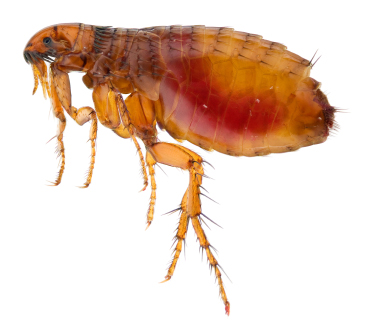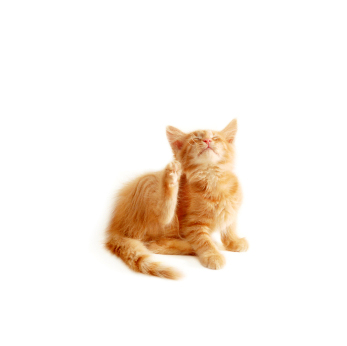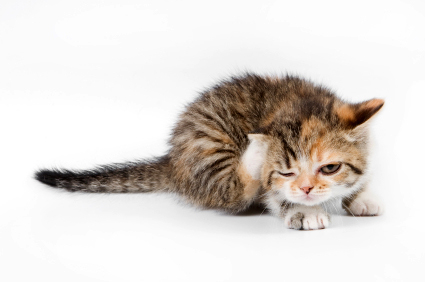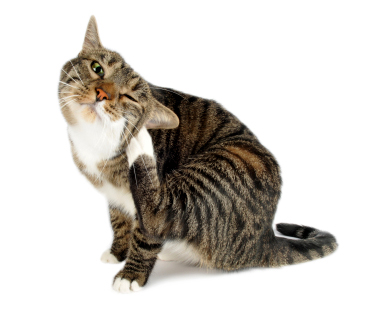Flea Allergy Dermatitis Treatment on Cats
Flea allergy dermatitis is diagnosed with a skin test. It is necessary to check the reason for itching, because there are many other reasons too which may cause it: ear infections, food allergy, lice, mites (sarcoptic mange), skin trauma… So even a biopsy may be necessary to find out if it is a case of flea allergy.
How to Treat Flea Allergy Dermatitis?
Best treatment against flea allergy dermatitis is of course preventing exposure to fleas completely – this is all the more important for the reason that flea allergy never goes away, and worsenw with age.
So, if your cat is allergic to fleas, you have to be on guard constantly. A new flea population hatches in two – three weeks – and at its worst the cat may have several generations of fleas in different stages on it, and this may cause new fleas hatching every few days.
Now it is important for you to understand that the fact your cat has flea allergy dermatitis does not mean you have a messy house. These annoying parasites may have travelled indoors from your yard in your clothes even. But once they find a host, they stay. In the past the fleas were present in warmer seasons, but now as central heating has made the homes warm all the year round, fleas find it comfy no matter what month you have on calendar.
Cleaning the House and Garden
So the first way to get rid of fleas is keeping your house clean. Did you know that at any given time the fleas that are actually on your cat’s skin are only 5% of the whole flea population? Surprised?
So where are the rest 95%? Guess twice… They are in their early stages of development – eggs, larvae, pupae - in your home, if your cat is an indoor cat. On carpets, furniture, floor… And even if your cat is an outdoor cat, you are bound to have these early stages of fleas in your house nevertheless. Not such a pleasant thought, is it…? Especially when they can remain that way for months is they don’t find a suitable host, and then get active when a cat comes around.
This may mean, that you may end up even changing your carpeting. But do try first some serious vacuuming and washing, and if you have that option, taking your carpets out to minus temperatures in winter for several hours. Wash your cat’s bedding and the areas around them carefully. Also disinfect the litter box and the area around it, and dispose of the feces properly. Use flea traps.
Groom your cat often to check for any signs of flea allergy dermatitis. If you find your cat is infected, keep it separated from other cats until it is treated (and keep it in an area where it cannot drop flea eggs on your furniture…)
You should use insecticides and insect growth regulators – these are products that kill fleas in all their stages of development on furniture, carpets and floors.
You can also use a flea bomb, but this means you and your pets must leave your home for a few hours. You should follow the instructions very carefully.
A flea bomb kills all other stages of fleas effectively except the eggs. These will take about a week to hatch, and then you have to use the flea bomb again. Still, it is very effective, if used in this way.
There are also household flea sprays that work fast and offer protection up to 12 months. An example is Feline Target Spray for Cat Fleas
When it comes to fleas on your yard (their normal habitat), there are insecticides that are meant to be used on your yard. Still, it might be easier to use the services of a professional exterminator.
Medical treatment of flea allergy dermatitis
First of all – do check with your vet which medical products you should use on your cat's flea allergy dermatitis. Do not use any other flea products than those specifically meant for cats. Other products (like the ones meant for dogs) can be toxic to your cat. And if you have more than one animal in the household – treat them all.
It is best to combine medication that kills adult fleas (adulticides) together with an insect growth regulator which kills fleas in their immature stages.
One of the safest insecticides found in many flea products (powders, shampoos and sprays) is pyrethrin. It is made of chrysanthemum flower extract. It disrupts the adult flea’s nervous system.
There are FLEA SHAMPOOS that are excellent in killing existing fleas, but of course they do not prevent your cat catching new fleas. This is why it is important to clean the environment so the cat is less likely to catch new fleas after ti has been treated.
There are certain restrictions in the use of flea shampoos. First of all, you should never use them on kittens without veterinary advice as they are too strong for small kittens. Your kittens could be poisoned if you use flea shampoos on them.
Read more about kitten fleas and their treatment here
Also you should never use flea shampoos for flea allergy dermatitis if the cat is on topical flea treatment – this build up of flea medicine is toxic and can be fatal.
Also long term use of flea shampoos may weaken a cat’s immune system – not to mention fleas developing resistance to shampoos. Also long-term use of flea shampoos may cause an itch and further allergic reactions. Therefore it is unnecessary to use flea shampoos if there are no fleas.
If, however, the cat has fleas, and you use flea shampoo, you need to bathe your cat every week (even twice a week) as an adult flea’s life cycle is two weeks. New fleas hatch every three days. This should tell you that you need to keep of treating the cat for fleas systematically, one flea shampoo wash does little in removing these parasites.
One good flea shampoo is Defendex™ Flea Shampoo
FLEA POWDERS
Flea powders used to be perhaps the most popular way of getting rid of fleas. But these days their popularity has gone down for the simple reason they can be toxic to your cat. Also they are not as effective as the more modern medicines,.
FLEA COLLARS
The problem with flea collars is that they emit pesticides your cat inhales (as do you when you pet your cat). Also they can cause breathing problems, diarrhea and nausea in the more sensitive cats.
Flea collars don’t stop the fleas getting elsewhere in the cat’s body than the neck-area.
One point about flea collars is also that they may get stuck (on branches etc) and injure the cat.
TOPICAL FLEA TREATMENTS
This treatment is an oily liquid applied to a cat’s neck (between the shoulder blades, where hair is cut shorter if necessary for easier application).
It absorbs through the skin to the cat’s blood and kills fleas that eat this blood. It prevents the eggs and larvae from hatching and growing and is very effective – toxic to fleas but harmless to cats. Another good point about topical fle allergy dermatitis treatment is that it kills other insects too, like ticks. If your cat is an outdoor cat it may not be a bad idea to use this kind of treatment on a monthly basis just in case.
When you use the topical treatment, the flea biting stops amazingly fast, even within minutes. Fleas should be dead in twelve hours time.
Do not use topical flea treatment together with flea shampoo as double medication is toxic, even fatal to a cat.
It may also cause allergic reactions in sensitive cats, and fleas may also develop resistance to topical treatment with time.
ORAL FLEA TREATMENT
The advantage of oral flea medication is that it leaves no residue on the cat’s fur. It prevents flea eggs from developing into maturity, but does not kill adult fleas. A cat does not need to take a flea pill often – sometimes even once a month is enough. It takes about a week for the pill to be effective.
STEROIDS
If your flea-allergic cat cannot avoid fleas, then corticosteroids can be used to ease the allergic reactions. Cats generally tolerate steroids better than dogs, but can develop side effects to steroids. This is why their long time use is not recommended.
ALLERGY SHOTS
Allergy shots can be used in flea allergy dermatitis treatment as well, but they are not always completely effective. Also these shots need to be continued on a regular basis – if the treatment is discontinued, the flea allergy dermatitis comes back. Also the amount of the allergen in the shots has to be very carefully monitored, as it is easy for the cat to be overdosed. If this happens, the cat will have the following overdose effects: circulatory problems, hives, restlessness and vomiting caused by nausea. These effects, however, are treatable.
ANTIBIOTICS
Antibiotics may be necessary, if secondary bacterial infections have developed. Flea allergy dermatitis causes such extreme itching that the cat may break its skin by excessive grooming which may lead to bacterial infections.
ANTIHISTAMINES are also used in cat flea treatment. These synthetic chemicals inhibit the histamine release in a cat’s skin and this eases the itching caused by allergic reaction to flea saliva. Antihistamines have to be rotated ever three months as a cat develops immunity to them in that time.
DIET
Diet has an effect of flea allergy dermatitis as well. Brewer’s yeast, garlic, herbs, minerals and vitamin B are helpful. With herbs it is wisest to ask expert advice as not all herbs are beneficial to the cat. Their effectiveness is caused by the fact they make the blood of the cat unappealing to fleas – and cause a deterring smell (which you probably won’t notice) that the fleas don’t like.
Omega 3 fatty acids (fish oil) calm down the cat’s overreacting immune system. They boost the cat’s immune system, and should be a normal part of the cat’s diet in any case.
NATURAL FLEA KILLERS
Even if something is called a natural cure, it is not synonym for safe – for example citrus oil can be fatal to your cat.
Just like with any other medication, expert advice is recommended. Natural ingredients can cause side effects and overdose just like any other medication.
The interest for natural flea killers has been rising because of the fact that the synthetic insecticide in prescription products may cause side effects.
One very good natural flea killer with insecticide properties is boric acid. It is a weak mineral acid which kills especially effectively the flea larvae. Sprinkle borid acid to a clean, vacuumed carpet and wait for a few hours. Then vacuum it off. You can also use borid acid to furniture in a similar way – letting it sit for a few hours and then vacuuming and viping.
And remember - it is not the end of the world if you find fleas on your cat. With proper, methodical treatment and cleaning your home can be cleaned of them, and your cat's flea allergy dermatitis can be treated. Fleas just are a nuisance every animal owner can meet at some point or another. And if that happens to be you and your cat, it is best to take action immediately – the quicker you react, the faster you and your cat can get back to normal life.
Go back to Fleas on Cats.
Go to Kitten Fleas
Back to Homepage from Flea Allergy Dermatitis Treatment
Back to Cat Illnesses from Flea Allergy Dermatitis on Cats
Disclaimer: This website is not intended to replace professional consultation, diagnosis, or treatment by a licensed veterinarian. If you require any veterinary related advice, contact your veterinarian promptly. Information at cat-breeds-info.com is exclusively of a general reference nature. Do not disregard veterinary advice or delay treatment as a result of accessing information at this site.
The photographs are all copyrighted and copying them is not allowed.
Leena's Books
Tutankhamun
|
This book travels with the King Tut - Treasures of the Golden Pharaoh exhibition on his world tour of ten cities from March 2018 onwards |
 |
|
Tutankhamun: In My Own Hieroglyphs tells the story, for older children, of the life and afterlife of the famous young pharaoh in his own words. Tutankhamun tells us about the trouble he got into as a child in Akhenaten's palace in the new city of Akhetaten, and how he became a boy pharaoh. As we learn, his life changed a lot when he died as a teenager, and long years of boredom started in his tomb with only his pet monkey Fingers and his treasure for company. He did meet some of the Egyptian gods, of course, and had fun scaring off tomb robbers, but it was mostly rather dull. Then one day, some new and strange people, including a Mr. Howard Carter, arrived and began to take all the treasures out of his royal tomb. Fortunately, through the eyes of his beautiful golden mask, Tutankhamun, could have fun again traveling around the world |
Mr Mummific

|
An ancient friend of mine, Mr Mummific dictated a book about how he became a mummy - and I was his scribe and artist. The book is available at Amazon.com and Amazon.co.uk On my other website www.ancientagypt101.com he continues his stories about life in ancient Egypt. |

|
Another hilarious adventure for children with Mr Mummific, the mummy with attitude. He now tells the story of his mishaps, misunderstandings and misadventures as he leaves his tomb through the False Door to embark on the complicated and dangerous journey to the Afterlife aboard the magnificent Ship of Millions. Find the book at Amazon.com and Amazon.co.uk |
The Nephilim Quest Series
The first book in an epic fantasy series based on human mythology. The search for the mythical Watchers, the angels who fathered the Nephilim, the half-angels. A story that moves on three levels - our times, ancient Greece and ancient Egypt.
Preview Nephlim Quest 1: Shadowhunter online
***
My Author Website at leenasbooks.com
Do you have experiences and tips
about treating fleas on cats?
Share your story and read
what others have said by
CLICKING HERE

















